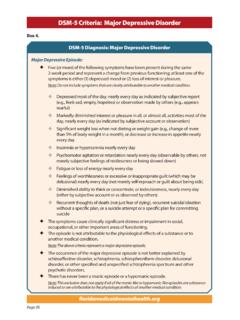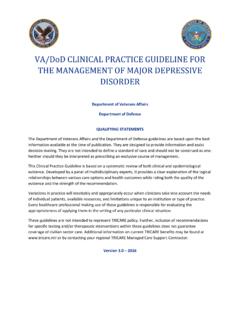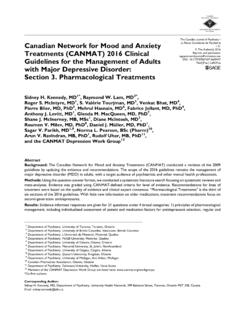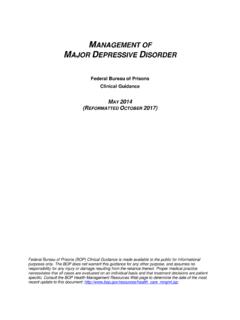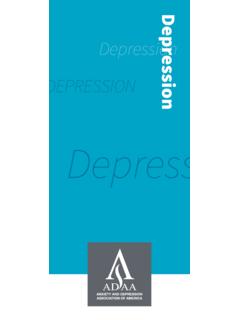Transcription of Interviewer Manual - complete
1 Columbia University DISC Development Group Interviewer Manual Prepared By: Fisher, Lucas, L., Lucas, C., Sarsfield, and Shaffer User Manual (English Generic, Spanish Generic, Present State & Voice DISC Interviews) March 2006 Table of Contents Section 1 Introduction page 3 Section 2 Computerized Versions of the DISC page 4 Generic C-DISC 4 page 4 Present State C-DISC 4 page 5 Voice DISC page 5 Section 3 Description of DISC Modules page 7 Demographic / Introduction Module page 7 Diagnostic
2 Modules page 8 Whole Life Module page 8 Validity of Whole Life Module page 8 Time Frame of Inquiry page 8 Administration Time page 9 Section 4 Introductory / Demographic Questions page 10 Parent / Caretaker & Youth Questions page 10 Orientation Questions page 10 Timeline Questions page 10 Voice DISC Introductory Section page 10 Why Ask These Demographic Questions? Page 11 Section 5 Timeline / Whole Life Charts page 12 Current Year Timeline page 12 Constructing the Current Year Timeline page 13 How to use the Current Year Timeline page 14 The Whole Life Chart page 14 Voice DISC Timeline page 15 Section 6 Question Structures page 16 Stem and Contingent Questions page 16 Age of Onset and Impairment Questions page 16 Treatment Questions page 17 Whole Life Questions page 17 Order of Questions page 17 Section 7 Interview Administration page 18 Instructions for Interviewers while in the Interview page 18 Questions that have [ ] and ( )
3 Page 21 Respondents Questions and Provocations page 21 Section 8 Interview Responses page 24 Response Codes page 24 Probing for Responses page 27 1 Section 9 Interviewers Diagnostic Modules page 34 General DISC Challenges for Interviewers page 34 Specific DISC Challenges by Diagnostic Modules page 34 Section 10 Supervisor Consultation page 43 Urgent Clinical or Ethical Issues page 43 Supervisor Issues page 43 Appendix 1 page 44 Historical Development and the DISC Editorial Board Appendix 2 page 46 Scoring of the Paper and Pencil DISC Appendix 3 page 49 Limitations for Modifications and Translations References page 50 2 Section 1 Introduction The Diagnostic Interview Schedule for Children (DISC-IV)
4 Is a fully structured diagnostic instrument that assesses thirty-four common psychiatric diagnoses of children and adolescents. The DISC is designed for Interviewer administration - either by lay interviewers (people with no formal clinical training) or by clinicians or by self-completion. The DISC-IV has been designed to obtain information about Diagnostic and Statistical Manual - IV (DSM IV) diagnoses, essentially by ascertaining the presence or absence of symptoms. The instrument uses the diagnostic criteria as specified in DSM-IV (with DSM-III-R, and ICD-10 in development). It does not elicit contextual information except to determine bereavement reactions, and specific rule-outs that would cast doubt on the diagnoses ( failure to speak in Selective Mutism when unfamiliar with English).
5 In addition, the DISC is DSM-IV loyal and all symptom criteria must be met to meet the diagnosis. The DISC cannot be used to establish a diagnosis for conditions that require the interpretation of specialized test results or to substitute for information derived from astute clinical observations. For these reasons, it does not cover diagnoses such as pervasive developmental disorders, speech and language disorders, or the organic brain syndromes. The DISC-IV was originally developed for use in large-scale epidemiological surveys of children and adolescents, but is now also being used in many clinical studies, screening projects, and service settings. Training for all DISC-IV interviewers is strongly recommended one to two days for the computer-assisted version, and four to five days for the paper-and-pencil version.
6 This Interviewer s Manual is designed to facilitate these trainings and to provide instruction on the proper utilization of this instrument. It provides information on the procedures that an Interviewer should follow during the administration of the instrument, as well as strategies an Interviewer can use when encountering potential difficulties. This Manual should be used as an aid to the understanding and administration of the DISC-IV. The focus of the Manual will be on the computer-assisted version (C-DISC), with specifically noted sections for the paper-and-pencil version. 3 Section 2 Computerized Versions of the DISC Three versions of the C-DISC 4 are available, all of which are copyrighted and distributed by Columbia University.
7 This Manual discusses each in a general manner, unless otherwise noted. A summary of each version follows: Generic C-DISC 4 Diagnostic System: DSM-IV, DSM-III-R, ICD-10 Note: C-DISC Diagnostic reports address DSM-IV criteria Applications: Paper or computerized ( Interviewer administered) Interviews: Parent (of children aged 6-17 years) and Youth (aged 9 17 years) Languages: English and Spanish Diagnoses: Anxiety Disorders: Agoraphobia, Generalized Anxiety, Overanxious (DSM-IIIR), Obsessive-Compulsive, Panic, Post-traumatic Stress, Separation Anxiety, Social Phobia, Specific Phobia Mood Disorders: Dysthymic Disorder, major depressive episode , Manic / Hypomanic episode Disruptive Disorders: Attention-Deficit / Hyperactivity, Oppositional-Defiant, Conduct Disorder Alcohol / Substance Use Disorders.
8 Alcohol use/abuse/dependence, Nicotine use/dependence, Marijuana use/abuse/dependence, Other Drug use/abuse/dependence Miscellaneous Disorders: Anorexia Nervosa, Bulimia Nervosa, Enuresis/Encopresis, Pica, Schizophrenia, Selective Mutism, Tourette s & Other Tic Disorders, Trichotillomania Time Period Assessed: Past year, current (past 4 weeks) & Whole Life (optional) Measures diagnoses that have occurred anytime in last 12 months Use: Epidemiological research, genetic & risk factor research, assessment of co morbid disorders, public health / school screening, treatment evaluation Administration time: Clinical population 90 to 120 minutes. Community population 70 minutes. Time of administration is dependent upon number of diagnostic modules administered and number of symptoms endorsed.
9 Program Scoring: Past month (embedded current) and past year diagnoses. Impairment score (out of 18) based on 6 impairment domains and 3 levels of severity Immediate report of clinically significant symptoms , suicide ideation Does not score Whole Life module separate SAS algorithms available for this. 4 Testing: Shaffer, D., Fisher, P., Lucas C, Dulcan, , Schwab-Stone, M.
10 NIMH Diagnostic Interview Schedule for Children, Version IV (NIMH DISC-IV): Description, differences from previous versions and reliability of some common diagnoses. J. Am. Acad. Child Adoles. Psychiatry, 39:1, January 2000. Present State C-DISC IV Diagnostic DSM-IV, DSM-III-R, ICD-10 Systems: (Note: C-DISC Diagnostic reports address DSM-IV criteria) Applications: Paper or computerized ( Interviewer administered) Interviews: Parent (of children aged 6-17 years) and Youth (aged 9 17 years) Languages: English Diagnoses: As above Time frame: Current (past 4 weeks) Note: time frame for inquiry varies according to DSM-IV requirements , past year for Conduct Disorder and Substance Use Disorders, past 6 months for ADHD Use: Public health/ school screening, intake assessment at mental health / primary care clinics, assessment of co-morbid disorders and treatment evaluation Administration time: Clinical population 90 mins (estimated).










